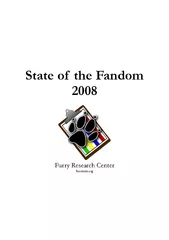PDF-State of the Fandom
Author : trish-goza | Published Date : 2015-07-26
2008 Furry Research Center furcenterorg 2 3 Table of contents x201CState of the Fandom 2008x201D current version as of 2100 27 June 2008 Starting stuff 4 Introduction 5 Background Demographic
Presentation Embed Code
Download Presentation
Download Presentation The PPT/PDF document "State of the Fandom" is the property of its rightful owner. Permission is granted to download and print the materials on this website for personal, non-commercial use only, and to display it on your personal computer provided you do not modify the materials and that you retain all copyright notices contained in the materials. By downloading content from our website, you accept the terms of this agreement.
State of the Fandom: Transcript
Download Rules Of Document
"State of the Fandom"The content belongs to its owner. You may download and print it for personal use, without modification, and keep all copyright notices. By downloading, you agree to these terms.
Related Documents














